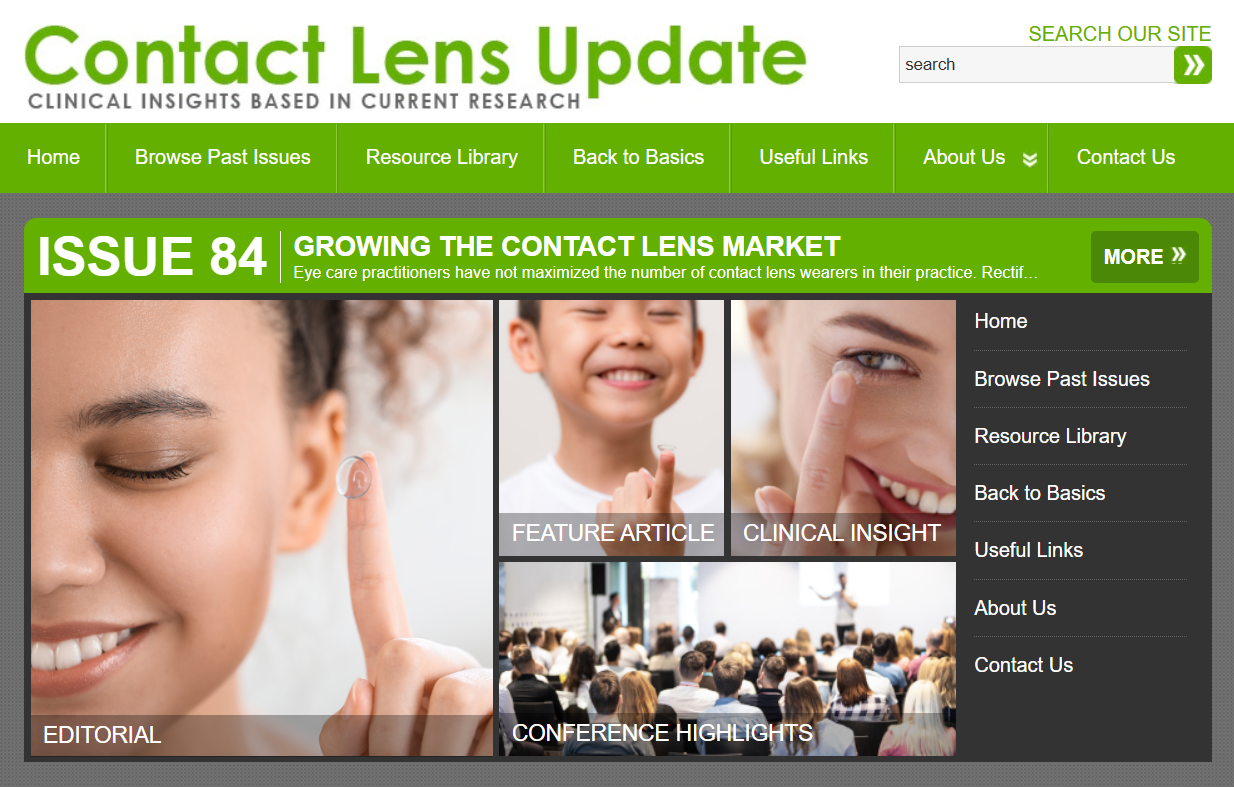- Jan 18, 2001
- 3,591
- 1,207
- 113
- School/Org
- ODwire
- City
- Lansdale
- State
- PA
WATERLOO, Ontario, June 30, 2025—The Centre for Ocular Research & Education (CORE) has published issue 84 of Contact Lens Update, which focuses on ways for eye care practices to increase the number of contact lens wearers and how to prevent patient discontinuation (dropout). The bi-monthly publication is available at no charge by visiting ContactLensUpdate.com.
“Contact lenses improve our patients’ quality of life while reinforcing loyalty to their eye care practice, resulting in a win-win situation for patients and practitioners alike. They represent a lucrative market with numerous clinical benefits, but the profession often fails to discuss the latest technological advances with existing lens wearers or forgets to recommend them as an alternative or complementary method of vision correction to spectacle wearers. The latest issue of Contact Lens Update serves as an important reminder of how practices can attract new lens wearers and optimize the experience for current and future lens wearers,” said Jill Woods, head of Clinical Research at CORE.
Mike McDougall, president of McDougall Communications in New York, authors the opening editorial. He summarizes a survey conducted by the Contact Lens Institute that investigated the opinions of 1,054 adults who required vision correction. It found that a significant number of people who have never worn contact lenses were highly interested in trying them, and highlights missed yet easily addressable opportunities where practices failed to discuss lens wear with prospective and former lens wearers.
The feature article summarizes a review of common barriers that prevent new contact lens wearers from successful use. Doerte Luensmann, a senior clinical scientist at CORE, outlines solutions that clinicians can use to combat these frequently encountered problems, including issues with vision, comfort, handling, and disinterest.
The conference highlight is contributed by Samantha Watson, a contact lens optician and affairs consultant at CooperVision in England. Her online survey and related interviews analyzed the emotional journey and expectations encountered among a group of recent lens wearers and/or people interested in trying lenses. The abstract contrasts the reality of contact lens fitting and dispensing against the number of actual visits, and highlights areas where better communication may improve the patient experience.
To help practitioners increase their number of contact lens patients, CORE has created a downloadable handout as this issue’s clinical insight feature. The PDF provides an overview of key points for practitioners to cover to attract new wearers, retain existing ones, and help identify issues that may result in patients ceasing lens wear.
In addition to a complete archive of back issues, ContactLensUpdate.com offers a resource library that provides no-cost professional tools, patient resources, images and video. It also houses complimentary technical training videos produced by International Association of Contact Lens Educators, plus an industry glossary. Industry professionals can access the latest issue directly from ContactLensUpdate.com or quickly sign up for email receipt of future issues.
The publication receives support from the educational arms of Alcon, CooperVision, and Johnson & Johnson Vision.
About the Centre for Ocular Research & Education (CORE)
The Centre for Ocular Research & Education (CORE) was established in 1988 at the University of Waterloo’s School of Optometry & Vision Science. Over the next three decades, the organization evolved from a three-person operation into a thriving hub of basic and applied research, collaborating with sponsors, agencies and academia on advanced biosciences, clinical research and education. Its uncompromising independence and results of the highest quality have been at the heart of many of the most prominent advances in eye health. Today, its team serves a range of ophthalmic sectors, including medical devices, ocular pharmaceuticals, digital technology and others, with a focus on the anterior segment. For more information, please visit core.uwaterloo.ca.

“Contact lenses improve our patients’ quality of life while reinforcing loyalty to their eye care practice, resulting in a win-win situation for patients and practitioners alike. They represent a lucrative market with numerous clinical benefits, but the profession often fails to discuss the latest technological advances with existing lens wearers or forgets to recommend them as an alternative or complementary method of vision correction to spectacle wearers. The latest issue of Contact Lens Update serves as an important reminder of how practices can attract new lens wearers and optimize the experience for current and future lens wearers,” said Jill Woods, head of Clinical Research at CORE.
Mike McDougall, president of McDougall Communications in New York, authors the opening editorial. He summarizes a survey conducted by the Contact Lens Institute that investigated the opinions of 1,054 adults who required vision correction. It found that a significant number of people who have never worn contact lenses were highly interested in trying them, and highlights missed yet easily addressable opportunities where practices failed to discuss lens wear with prospective and former lens wearers.
The feature article summarizes a review of common barriers that prevent new contact lens wearers from successful use. Doerte Luensmann, a senior clinical scientist at CORE, outlines solutions that clinicians can use to combat these frequently encountered problems, including issues with vision, comfort, handling, and disinterest.
The conference highlight is contributed by Samantha Watson, a contact lens optician and affairs consultant at CooperVision in England. Her online survey and related interviews analyzed the emotional journey and expectations encountered among a group of recent lens wearers and/or people interested in trying lenses. The abstract contrasts the reality of contact lens fitting and dispensing against the number of actual visits, and highlights areas where better communication may improve the patient experience.
To help practitioners increase their number of contact lens patients, CORE has created a downloadable handout as this issue’s clinical insight feature. The PDF provides an overview of key points for practitioners to cover to attract new wearers, retain existing ones, and help identify issues that may result in patients ceasing lens wear.
In addition to a complete archive of back issues, ContactLensUpdate.com offers a resource library that provides no-cost professional tools, patient resources, images and video. It also houses complimentary technical training videos produced by International Association of Contact Lens Educators, plus an industry glossary. Industry professionals can access the latest issue directly from ContactLensUpdate.com or quickly sign up for email receipt of future issues.
The publication receives support from the educational arms of Alcon, CooperVision, and Johnson & Johnson Vision.
# # #
About the Centre for Ocular Research & Education (CORE)
The Centre for Ocular Research & Education (CORE) was established in 1988 at the University of Waterloo’s School of Optometry & Vision Science. Over the next three decades, the organization evolved from a three-person operation into a thriving hub of basic and applied research, collaborating with sponsors, agencies and academia on advanced biosciences, clinical research and education. Its uncompromising independence and results of the highest quality have been at the heart of many of the most prominent advances in eye health. Today, its team serves a range of ophthalmic sectors, including medical devices, ocular pharmaceuticals, digital technology and others, with a focus on the anterior segment. For more information, please visit core.uwaterloo.ca.





